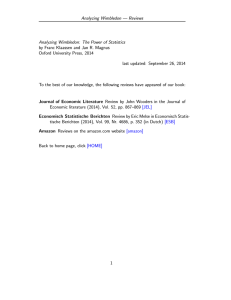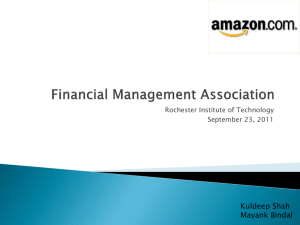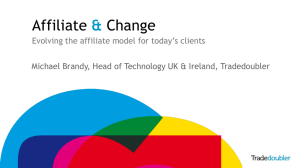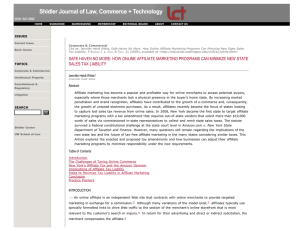Business Model 2 chapter - E-Help
advertisement
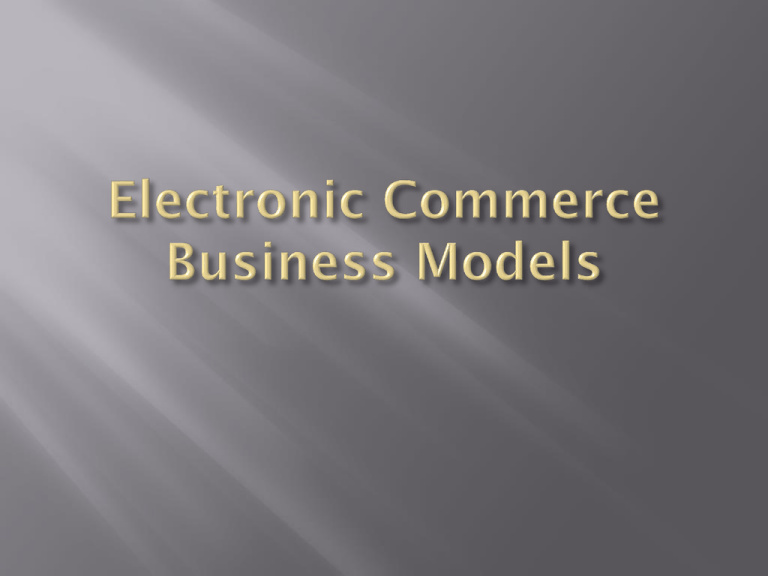
•A business model describes a set of business entities and interrelationships among them. The model describes the sources of revenue and potential benefits accruing to the involved business participants. •The business model provides the broad perspective necessary for identifying appropriate solutions at some level of abstraction. The identified solution should be sustainable in terms of revenue & capable of realizing the stated objective. EC has grown at lightening speed due to growth in high speed internet connectivity & evolution in publishing, distribution, payment & security technologies. To cope with the evolution , business model s have been evolving at a rapid rate. Web advertising methods Increasing no of visitors. Yahoo! With over 100 million page views Amazon.com with 6 million registered users, became attractive ground for the advertisers. Facebook Rediffmail Google Content Vs Transaction Native Vs Transplanted These Classifies the internet business models into 4 categories: >Native Content based Models >Native Transaction Models >Transplanted content based Model >Transplanted Transaction based Models Native Content based Models emerged due to the efforts of many amateurs who set up informational web sites expecting no financial returns. Free access sites Based on the nature of content the various models that have appeared include: 1. Information Content Model 2. Freeware Model 3. Information Exchange Model The web today is probably the largest source of information, available free of cost to the users. Many websites were set up by amateurs, containing scientific, country, culture and tourism related information. Many other websites organized the plethora of available information content in the form of virtual online libraries . Attract visitors by offering information In the early stages of Web developments – Major source of Information Contents were scientists, Academicians and Researchers • The Information is typically available at no charge basis • It is typically utilized by agencies and groups interested in wide dissemination of information For example, • Virtual Library -- http://www.vlib.org • International Council of Museums– http://www.icom.org/vlmp • National Informatics Center, India– http://www.nic.in s/w companies have extensively utilized the freeware model to offer downloads of their products. Web browsers by Netscape and Microsoft have been available for free downloads to individual users. Google Chrome, Mozila Firefox, Opera, etc This model has been largely responsible for popularizing the web. Music, picture, educational tutorials(e-books) • Distribution of cooperatively developed free software prototypes, products, patches and demonstration versions. • The contents (software packages) can be downloaded at no incremental cost. • For Example • Linux – http://www.linux.org • GNU -- http://www.gnu.org • Apache Web server – http://www.apache.org This model is based upon the exchange of information between individuals and organizations over the internet. The information captured, during the interaction, about a person can be used for building the profile of individual users. The profile can be later utilized by target marketing and advertising companies for screening out and creating mailing list. User may provide information voluntarily as a part of registration process. hotmail.com, yahoo.com, amazon.com With growing acceptability and audience on the internet, many traditional economy businesses saw an opportunity to generate revenues on the internet landscape. The traditional content providers-journals, research databases, directories and advertising-have moved their content to the internet. As a result, information providers and brokers have transplanted businesses on the internet to take advantage of the growing audience. Content creators and publishers have relied on a subscription based service model. scientific journals, newsmagazines, and other periodic content have been offered, on a subscription basis. Leading publishers and creators of digital content have adapted the same subscriptions based model on the internet. In addition many news services, and valuable audio and video content are also available in digital format. Web sites providing content, e-mail, chat sessions, and discussion forums are utilized for serving advertisements to content viewers. Usually, such sites provide content and services free of cost and generate revenue through the advertisements they display. It is the basis of the growth and success of many search engine companies such as yahoo ! The model is derived from commercial television and printpublications, that make their basic revenue from the advertisement stream. The model has several variations, banner advertisement being the most popular form. Banner advertisement are served to users visiting one of these popular sites for content or service. An infomediary company is the one that collects a personal profile from its users (consumers and /or suppliers) and subsequently markets that to interested set of users, while maintaining the data privacy. In the process it also offers the user a percentage of brokered deals or other services. The infomediary model is based on the premise of lowering the interaction cost to consumers during the process of searching for suitable products/services and prices. Consumers incur substantial interaction costs in trying to locate and discover the price of products in cases where product lines change rapidly due to technological or marketing evolutions, and where the pricing is complicated. For example, e-machine (http:/ /www.emachine.com), a computer hardware seller, collects information and sales data during the interaction .the collected data is sold to other businesses that are interested in targeting a specialized set of customers. The Affiliate Model achieves traffic aggregation for the e-retailer at almost no risk. The Affiliate companies offer sales of other manufacturers or e-retailers’ products on their web sites, for an incentive. The visitors of the affiliate site may choose to click on an item or service offered by the e-retailer at the affiliate web site. The affiliate site redirects the sales transaction to the sponsoring e-retailer or manufacturer, where the actual transaction is carried out. For example, amazon.com offers its affiliate program as amazon associate program. Anyone can join the associate program for free by creating an account with amazon.com and featuring a link to amazon.com on their web page. Every time a visitor clicks through from the associate to amazon.com, and makes a purchase, the associate site earns a generous commission of up to 15% of the purchase value. The entire shopping experience i.e., selection of product, payment, fulfillment, delivery and customer service is taken care of by amazon.com This section features models that are native to the internet and were either born out of necessity on the internet or are suited for the it. These models includes- digital product merchandising, internet access provision, providing software and services for creating & maintaining websites and finally, a new kind of intermediary that aggregates & presents the info to meet the users objectives rather than those industry segments. • Network Infrastructure is at the foundation of growth of electronic commerce • Various modes of Internet Service Providers – Dial-up Services – Cable based services – DSL and ADSL – Leased Line services • Payment options – Flat rates – Bandwidth based flat rates – Usage based – Free Access (in lieu of advertisement viewing) • Electronic Shops and Businesses require 24x7 presence, upkeep, maintenance • Also, common services like transaction security and payment services • SMEs may not have expertise and the cost to get on electronic marketplace by addressing all infrastructure issues may get too high • In this business model, the infrastructure company provides complete set of services required for hosting your business online. • Yahoo Shops, iCat’s Lemonade Stand, Pugmarks.com • Other services related to Speeding up the access across the globe etc. Storeowners, catalog-based sellers, manufacturers & brokers- financial, servives insurance agents, travel services agents – adapted the traditional business model to increase their reach & reduce the market friction. 3 of these models are described here In this model , customers interact with the seller through a web based interface for gathering & analyzing the information needed for an informed decision. Press -> BUY NOW Seller request the buyer to select Payment Mode Validation using payment gateways or electronic currency provider Delivery process- shipping & handling department • Market makers, also known as brokers, play an important role of facilitating the transactions by bringing the buyers and seller together • Commission based Services • Model – Transplant the per transaction/value based commission model by bringing the sellers and buyers on electronic marketplace For Example • Stock brokers- Charles Schwab, ICICIDirect • Flowers- Teleflowers • Auctions- BaZee.com, AuctionIndia.com From Manufacturer to Consumer • Product passes through several intermediaries • The cost of product increases in the distribution process • Each intermediate layer assists in the distribution and logistics • If a manufacturer is capable of direct distribution- it can reduce the distribution cost. – In the process, it may need to handle several distribution and logistics issues – The customer feedback can be direct, and thus create an opportunity for mass-customization • Example- Dell Computers

